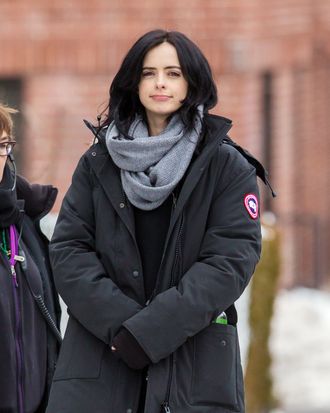
“Have people always had ‘Canadian’ labels on their winter coats?” my sister asked me one morning in January. “Or is Canada just engaging in a really good branding exercise?”
The answer, of course, isn’t that Canada the country is doing an excellent job feathering its own nest, but rather that Canada Goose, the manufacturer of recently everywhere puffer coats, is. The winter of 2015, currently best known for having the third-coldest February in New York City history (a bronze medal that, like all bronze medals, doesn’t feel like it adequately rewards the extreme pain it took to get to the podium), should instead be remembered as the Winter of Canada Goose. All of a sudden, it seemed, they were everywhere, with the bright red, white, and blue label making them easy to catalogue and difficult to ignore. Four in my subway car last night. Three spotted on the five-minute walk to my station this morning. They’re North Face jackets that have grown up and moved to the big city from the suburbs. (Or gone off to an Ivy League college.)
Except, of course, Canada Goose jackets are several times more expensive than North Face, starting at around $700, and going well above $1,000, making the jaunty little sleeve patch look less like a piece of flair and more like a convenient bull’s-eye for when the revolution comes and all its wearers are lined up against the wall.
Like Hummers and North Face and Land Rovers before it, Canada Goose jackets didn’t start out as items to be owned by consultants and lawyers, but rather as performance gear for the coldest of weather. Its spokesperson is an Iditarod champion who wears the brand while racing. According to its website, the “Expedition Parka,” which you may have seen on someone smoking a cigarette outside a West Village wine bar or draped around a chair at a Cobble Hill brunch spot, was originally made to outfit scientists working at the McMurdo Station on Antarctica. The company, which brags that it makes the “warmest jacket on earth,” sold a majority ownership stake to Bain Capital in 2013, and, over the past ten years, has seen its revenue go from an annual $5 million to $200 million. (Who knows what the total will be once the Winter of Canada Goose is finally over!)
This growth was the result of a deliberate campaign. Canada Goose has been spotted on a number of movie stars — which may or may not have something to do with its practice of handing the coats out for free to certain people at Sundance, which it helped sponsor — but that has resulted in an unexpectedly glamorous set of associations for a garment that both adds bulk, and is Canadian. Then, too, the goose feathers, the company touts, are not only “free-range,” they are Hutterite, thus appealing to the sort of person who likes their eggs organic and from Amish country.
Like all smart marketing, Canada Goose has tapped into existing biases. American preppiness has always been aligned with sensible, understated outdoorsiness. A fur coat might keep you warm, but it’s flashy. You can’t exactly wear it and feel hardy. And nothing has made Northeastern city-dwellers of the past few climate-changed years feel quite so hardy as surviving winter. It will only get worse, we think to ourselves as we read the dire one-two punch of the weather pages and the science news. Who knows how bad? This is the kind of thinking that has made the purchase of these jackets seem more about being prudent than about seeking out a status symbol.
But an $800 wearable sleeping bag is not actually sensible. I know this because my own coat is a far less expensive wearable sleeping bag that keeps me perfectly toasty, at least the parts of my body it covers. (My face is always freezing, but so is that of the Canada Goose–wearer, since as far as I know no model comes with a built-in balaclava.) And this is where I think the phenomenon veers away from just being the latest item in an ever-evolving series of upscale signifiers. A Canada Goose (or a Moncler, or whatever your preferred brand of premium down may be) is an attempt to “disrupt” the dread of winter, in an era when we have placed our faith in technology — which is what Canada Goose really is, more than it is fashion.
Wearing a coat meant for coldest Antarctica on your six-minute walk to the subway isn’t about that walk; it’s not about buying something you can wear year after year — the seductively dull certainty that’s at the heart of prep style. It’s not even about whichever vortex we happen to find ourselves in, which is rarely as dire as threatened. It’s about feeling prepared for the imminent unknown, for a future in which Smith Street really is a tundra, and the sense that, should the apocalypse (or just an even colder winter) really arrive, your outlay of cash has left you better prepared than the fools who shop at J.Crew, or even L.L Bean. It’s a coat for an age in which the seas might be rising and social safety nets might be fraying, but, we imagine, there will be a way to hack those problems. Canada Goose’s real marketing genius lies in making the wearer feel insulated against far more than just the cold.




